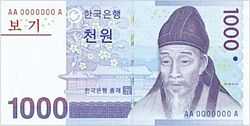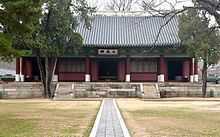Sungkyunkwan
| Sungkyunkwan | |
.jpg) Myeongnyundang of the Sungkyunkwan. | |
| Korean name | |
|---|---|
| Hangul | 성균관 |
| Hanja | 成均館 |
| Revised Romanization | Seonggyungwan |
| McCune–Reischauer | Sŏnggyun’gwan |
Sungkyunkwan, also called Taehak (태학, 太學), was the foremost education institution in Korea during the late Goryeo and Joseon Dynasties. It is located in its original location at the bottom of the Seoul campus of Sungkyunkwan University. Today, it is managed by the local government. Twice a year, the ceremonial rite Seokjeon Daeje is performed here to honor Confucius.
History
Gukjagam (국자감,國子監), the highest education system during the Goryeo Dynasty, was established in November 992 by King Seongjong. Gukjagam was renamed Sungkyunkwan in June 1304, and then relocated to the old site of Seongmun-gwan in 1367 during the reign of King Gongmin near the end of the Goryeo Dynasty.
After the founding of the Joseon Dynasty in 1392, King Taejo relocated Sungkyunkwan to Hanseong, current Seoul, and also founded 360 Hyanggyos nationwide in July 1398, establishing a national education system.
Sungkyunkwan was destroyed by fire in 1400 and rebuilt in 1407. Sungkyunkwan was rebuilt again in 1601 after it was destroyed during the Japanese invasions.
During the colonial era between 1910–1945, royal Sungkyunkwan was demoted to a private institution and renamed Gyunghakwon, while Korean education was prohibited and Japanese education was forced nationwide.
After Korea gained independence in 1945, Gyeonghakwon was renamed to Sungkyunkwan and with funding from Yurim (Confucians) nationwide, Sungkyunkwan University was established.
The current Sungkyunkwan buildings are reconstructions built in 1988. Confucian ceremonies are held here twice a year in the second and eighth months of the Lunar calendar.[1] The ceremony in the eighth month is on Confucius' birthday, which is a school holiday for SKKU students.
Buildings and administration
- Myeongnyundang (명륜당): the main lecture hall, pictured on the 1,000 KRW bill
- Daeseongjeon (대성전): shrine which holds a memorial for Confucius.
- Dongmu (동무) and Seomu (서무): shrines which holds memorials for Confucius' ten students, and 18 Korean scholars.
- Jongyeonggak (존경각): Korea's first library, built in 1475
- Dongjae (동재) and Seojae (서재): east and west dormitories
- Bicheondang (비천당): examination building
- Jegigo (제기고): storage building for ceremonial dishes
- Jinsasikdang (진사식당): dining hall
- Jeongnokcheong (정록청): administration building
- Tangpyeongbigak (탕평비각): a monument displaying a message from King Yeongjo reading "To be in harmony and not to form factions is the fair mind of a just man. To form factions and not to be in harmony is the mind of a petty man."
- Sinsammun (신삼문): the main gate of the campus, which is only opened during ancestral ceremonies to allow entry to the spirits of deceased Confucian scholars
- Ginkgo trees: the two oldest ginkgo trees in Sungkyunkwan (Natural Monument No. 59) were planted in 1519. The ginkgo leaf is the modern symbol of Sungkyunkwan University. It is said that Confucius liked to instruct his students under the shade of ginkgo trees. All trees in Sungkyunkwan are male, not bearing fruit, as the institution originally forbade any females from entering.
The institution's administrator had a government rank of sampum (삼품), with lower-ranking officials of Jwaeju (좨주), Akjeong (악정), Jikgang (직강), Baksa (박사), Hakjeong (학정), Haknok (학록), Hagyu (학유) as supporting staff.
Education
Sungkyunkwan's teachings were mainly Confucian-related, and was largely aimed at preparing students for government services. The main goal was for the students to pass the civil service examinations, also known as gwageo, which assessed the ability to interpret the Chinese classics in terms of official Neo-Confucian ideology.
The set number of students were 150 when Sungkyunkwan was founded, and raised to 200 in 1429. Each year, only 30 students could graduate.
Entrance examinations for Sungkyunkwan were extremely harsh, and was only allowed for the sons of high-ranking officials or yangban. The students composed two factions, coming from the empowered Hungu faction or the more radical Sarim faction, better known as seonbi.[2] Throughout the 15th and 16th centuries, there were four major purges related to conflict between these groups, often involving Sungkyunkwan students.
There were two ways to be accepted into Sungkyunkwan. Either the students had to pass the two admission exams, Saeng-wonsi (생원시) and Jinsasi (진사시), or take the other two examinations, Seungbo (승보) and Eumseo (음서). If they passed these examinations, they were given the opportunity to be accepted.
Once accepted, the students had to complete the curriculum and also fulfill the minimal attendance score of 300 Wonjeom (원점) to qualify for the first test of the civil service exams. Students lived very comfortably on full scholarship and were waited on by servants.[3]
Images
-

The 1000KRW banknote shows Confucian scholar Yi Hwang and Myeongnyundang.
-

This map from 1785 shows the original campus of Sungkyunkwan. Most of the buildings to the west are gone.
-

Bicheondang
-

Daeseongjeon, with the doors open
-

Jongyeonggak, Korea's oldest library
-

The lecture hall of Sungkyunkwan
-

This building enshrines tablets to the great Confucian scholars.
-

Sinsammun opened its doors for APAIE delegates on 17 March 2014.
-

Tangpyeongbigak
Notable alumni
- Jeong Inji
- Shin Suk-ju
- Jo Gwang-jo
- Yi Hwang
- Yi I
- Yu Seong-ryong
- Hyomin
See also
- Education in the Joseon Dynasty
- History of Education
- Gukhak
- Gukjagam
- Songgyungwan at Kaesong
- Sungkyunkwan University
References
| Wikimedia Commons has media related to Sungkyunkwan. |
- ↑ "Old Sungkyunkwan". Retrieved 16 April 2014.
- ↑ Dunbar, Jon (15 April 2014). "Sungkyunkwan, the royal university of Joseon". The Korea Blog. Retrieved 16 April 2014.
- ↑ "Sung Kyun Kwan". Exploring Korea. Retrieved 16 April 2014.
External links
- Official website (Korean)
| |||||||||||||||||||||||||||||||||||||
